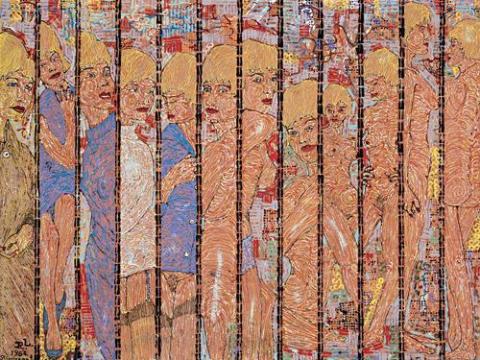STRIPPERAMA NO.4, 1964
Richard Larter
enamel on composition board
91.0 x 121.0 cm
signed, dated and titled lower left: RL/ 1964/ Stripperama 4 inscribed verso with artist's name, address and title
Watters Gallery, Sydney (inscription verso)
Private collection, Melbourne
The art of Richard Larter combines politics and pleasure in the celebration of sex and as a challenge to society's attitudes and taboos. As Kelly Gellatlysaid in the Heide Museum's catalogue to the exhibition, Strippperama: Richard Larter, 'In Larter's world, sex, desire, pleasure and the related aspects of voyeurism and performance are not only natural, but to be celebrated.'1 Such ideas and pleasures run throughout his art, voyeurism and performance being to the fore in his Stripperama paintings. While the political side of his art is more apparent in his later work, attacking the evils of war, power and politics, his 1960s paintings of women, such as The Modern Olympiad 1963 (Laverty Collection, Sydney) and its references to Edouard Manet's 'scandalous' Olympia of 1863, also have political intent. It was an offence to exhibit sexual subject matter during the sixties, as Mike Brown found out when arrested in 1965.
While Larter's art is confrontational in its indictment of contemporary society, it is similarly confrontational in its celebration of the female figure, mixing humour with the pleasure of looking. Among the paintings of the early 1960s, Stripperama No. 4 is a classic. Combining the fixed image, caught in the act, with a sense of continuing movement, it is appropriately divided into twelve vertical strips, each revealing a different stage of the performance. Moving from left to right, the blond-headed stripper in fawn coat is presented progressively undressing until she is wearing nothing but her lipstick. In profile and full frontal, she presents her body with disarming directness, inviting admiration. The separately painted strips (remember the artist's sense of humour) heighten the tantalising moments and recall the flicker of lights sometimes used for similar effect as it reveals each enticing stage of the strip. The delights of the female form are also heightened by the technique, Larter at this stage using the hypodermic syringe as a painting tool. Bosoms, bellies and backsides are delineated in sensuous line in a combination of the figurative and abstract unique to his art.
1. Gellatly, K., Stripperama: Richard Larter, Heide Musuem of Modern Art, Melbourne 2002, p.24
DAVID THOMAS
